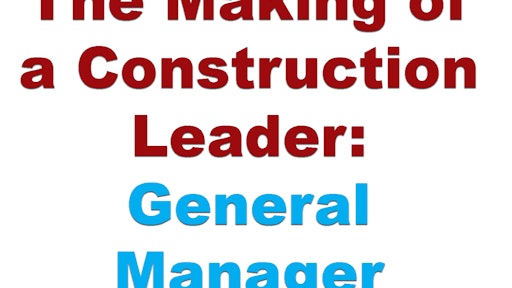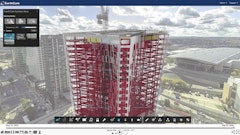
The role of general manager is a role that is designed to be active and engaging. The GM is paid to “make things happen.” As the great basketball coach John Wooden once said about leadership, “Failure to act is often the biggest failure of all.”
Thus, the construction general manager must be engaged and active in leading, directing and motivating all the right people and processes to produce a profitable result.
So you’ve decided you need a general manager. Here’s how to make one.
Step #1 – place new general manager on a scheduled growth plan
Assuming you will incorporate the skills listed in the article 8 Skills of an Effective General Manager to assist your hiring/promotion efforts, it is critical to place the new GM on a scheduled growth plan that you can monitor. The first six to 12 months might be used to work with your new GM, depending on what his background is and where he learned (or earned) his stripes.
I think it wise to have the new GM submit to an assessment of sorts on how strong he is at the skill areas identified in the above article. Then, assuming he has one or more areas to improve, if not to learn from scratch, work to develop a schedule of learning, debriefing with you and monitoring. Such an effort will produce greater alertness and intent on the new GM’s part and keep you in the know about how your new general manager is coming along.
Step #2 – gradually expose general manager to expanding “circle of contacts”
Depending on the recent experience of your new general manager, you will want to gradually add to his contact bank those individuals whom he will need to have access to and interaction with. Consider the expanding “circle of contacts”:
- Direct reports, peers and senior leaders (internal)
- Suppliers and vendors
- Customers
- Social network, community, local associations, etc.
Notice that the first “ring” includes all of your internal workers. The GM must obviously get to know and understand each of the company leaders and their roles if he is to fully resource their efforts. Suppliers and vendors are critical to meet so that the GM can assess what your construction company is using, how much you are paying and whether or not better purchasing decisions can be made.
While it appears that customers fall farther away than they should, it is important that before your GM initiates a lot of customer contact that he has a solid understanding of “what we are about” and “how we do things.” This is the only reason for the customer’s placement in an outer circle. Finally, introducing and engaging the GM into the areas that provide outlets for business development and community good will is important to round out the GM education.
Step #3 – direct general manager to assess your construction systems & processes
A key benefit to engaging a general manager is that of improving your organization, or at least that portion of the organization that the GM will be leading. It is paramount that you receive a clear, unbiased and accurate assessment as to how things are really performing. This step can be a bit dicey for some GMs, especially if they have come from outside the company. Why? Because when you start “sniffing around” how things have been done in the past you’re bound to stir up some emotional heartburn of workers who would rather just leave things as they are.
You’ll want to help pave the way for your GM to start his assessment by educating your workers and other leaders as to the purpose of the GM’s efforts and its importance to the company in the end.
Step #4 – move the general manager to produce performance results ASAP!
Produced performance results should reflect not only what the financial picture looks like but also what process success we are experiencing. Consider a few examples of the non-financial performance results that you might see measured:
- Customer satisfaction
- Rework
- Call-backs
- Safety (incidents, days without injury)
- Equipment “up-time”
- Employee attendance, absenteeism, late arrival
- Number of pre-project meetings conducted
- Number of weekly, bi-weekly planning schedules produced
The performance results of these items, and others, can be quite telling about what is really going on in the company and what “squeaky wheel” needs the grease first.
Step #5 – schedule regular general manager, owner & HR meeting
There is perhaps nothing as frustrating as dealing with today’s employment issues. Whether it is harassment, benefit issues, or just getting some employees to work on time, such things take a lot of time and energy for the general manager. If you have a Human Resource Manager on staff be sure to schedule regular update meetings for employee-related issues. This also provides a debrief opportunity for the GM to ask private questions, to confirm recent employee treatment or simply to solicit advice on anything he needs to adjust in his own leadership.
Step #6 – require the GM to set strategic objectives and performance goals
After the first four to six months your general manager should be getting fairly comfortable with what she knows and who she knows. She should have a much clearer picture as to your company’s work processes, employee needs and performance potential. It is at this point that I would suggest that you engage her to develop three to five strategic objectives for either her division or your company, depending on what she is leading.
For each strategic objective — that is, for each of her long-term objectives she feels the division or company can attain, have her also develop two or three specific goals. The goals should be short-termed in time and specific with respect to performance, cost, savings, etc.
Step #7 – require the general manager to provide you with the “Hi-Lo” Report
This report should be required of the GM starting with the first week on the job. The “Hi-Lo” Report is designed to be a weekly update of the “highlights and lowlights” experienced by the GM and/or the division or company.
Here is a simple format to use.
- 3 to 5 highlights that reflect positive decisions, results, efforts, etc., that were experienced in the most recent week
- 3 to 5 lowlights that reflect difficult situations, challenges, or failures that were experienced in the most recent week
The secret here is to keep the “Hi-Lo” to only one page of bulleted points. It is not intended to be pages and pages of information. Bullet points are to be used to briefly convey the division description of what was experienced.
This is to keep the general manager from wasting hours on another “darn” report. It should be sent to the contractor/owner or other senior leaders as needed. If the owner and leaders read a bulleted point that they want more clarification on they can request more detail from the general manager.
In the past, a construction company might have hired a general manager to run the shop, the equipment yard, perhaps even a new start-up office. While such hires are certainly within the scope of what has been presented over the last two weeks the role of the GM can actually be expanded to include other situations.
If you are considering bringing the general manager role to your construction company, seek as many of the skills listed in the previous article as possible for your new hire. Work up a GM profile of the skills you feel would benefit the general manager role that your company needs. Then, once hired, work the seven steps from this week’s article and watch the progress your GM will make in his (or her) growth.
Take a more specific route to the making of your general manager!



























